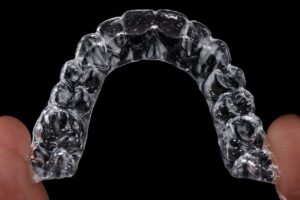One of the most common questions people ask before starting Invisalign is simple: Invisalign how long does it take? It’s a fair question, especially when you’re trying to plan around work, school, or important events. The truth is, the timeline can vary depending on your specific case. Some people see results in just a few months. Others may need a year or more.
Learn what actually affects how long treatment takes. Some real-world examples from patients are also featured so you can get a more realistic idea of what to expect.
What Affects Invisalign Treatment Time?

Everyone wants fast results, but nothing happens overnight—especially with smile correction. Invisalign treatment, in particular, doesn’t work on a fixed schedule. The length of your journey depends on a few key factors, like case complexity and how consistently you wear your aligners. Knowing these details early on can help you set the right expectations from day one.
Case Complexity
The biggest factor is how much your teeth need to move. Here’s a quick breakdown:
-
Mild cases (like small gaps or slightly crooked teeth) can take as little as 3 to 6 months.
-
Moderate issues (mild crowding or minor bite problems) usually take 6 to 12 months.
-
Severe crowding or bite correction may take 12 to 18 months or more.
Your orthodontist will review your scan and let you know what category your case falls into.
Age and Bone Response
Younger patients usually respond faster because their jaws and bones are still developing. That doesn’t mean adults don’t see great results—just that it might take slightly longer.
Consistency: Wearing the Aligners
Invisalign only works when it’s worn. You’ll need to keep your aligners in for 22 hours a day, removing them only for eating, brushing, and flossing. People who follow this schedule closely often finish faster than those who don’t.
Attachments, Elastics, or Refinements
Some cases need extra features like attachments or rubber bands. Others may need refinement trays toward the end of treatment. These can add a bit of time, but they’re often necessary for the best outcome.
Invisalign: How Long Does It Take? Real Patient Timelines
Sometimes, the most helpful information comes from people who’ve already been through the process. Treatment plans vary, but real stories can give you a better sense of what’s typical.
Below are three real patient timelines based on different case types. Each one started Invisalign with a specific goal and followed through with consistent wear and check-ins.
Sarah, Age 27 – Mild Spacing
Treatment Time: 5 months
Sarah had a small gap between her two front teeth. Her aligners were straightforward, and she didn’t need attachments or elastics. She wore her trays consistently and switched them every 10 days. Her treatment wrapped up in just under half a year.
Jason, Age 35 – Moderate Crowding
Treatment Time: 10 months
Jason’s lower teeth were crowded, and a couple of his top teeth were slightly rotated. His plan included attachments and some minor refinements toward the end. He wore his aligners 22 hours a day and stayed on track with appointments. Ten months later, everything was aligned.
Lena, Age 18 – Overbite and Spacing
Treatment Time: 14 months
Lena’s case was more complex. She had a noticeable overbite and spacing issues. Her treatment included attachments and elastics to shift the bite. She stayed consistent, but the movements required more time. By month 14, her bite and smile were fully corrected.
What These Timelines Show
-
Results aren’t instant, but they’re steady.
-
Following the wear schedule closely makes a difference.
-
Even longer cases stay manageable when expectations are clear.
These are just three examples, but they show how the question How long does it take really depends on the starting point—and how committed you are to the process.
What You Can Do to Stay on Track
If you’re wondering how long Invisalign take, there’s good news—you can influence the outcome. While some factors are out of your control, your daily habits make a real difference in how fast and how well things move.
5 Ways to Avoid Delays
-
Wear aligners 22 hours a day
This is non-negotiable. Every hour they’re out slows down progress. -
Switch trays on schedule
Most people change trays every 7 to 14 days. Don’t push it unless your orthodontist says otherwise. -
Keep aligners safe and clean
Lost or damaged aligners can add weeks to your timeline. Always carry your case and avoid wrapping them in napkins. -
Go to all scheduled check-ins
These visits let your orthodontist confirm progress and make any needed adjustments. -
Follow the extra instructions
If your treatment includes elastics or attachments, use them exactly as directed.
Mistakes That Can Slow You Down
-
Forgetting to wear aligners during the day or overnight
-
Delaying tray changes without permission
-
Skipping check-ins or ignoring fit issues
-
Letting aligners warp from hot water or drinks
The more consistent you are, the more predictable your treatment will be. It’s a team effort—your aligners do the work, but only if you give them the time they need each day.
How Long Does Invisalign Take Compared to Braces?
If you’re weighing options, it helps to see how Invisalign stacks up against traditional braces. Both can deliver excellent results, but the time commitment isn’t always the same.
Average Treatment Times Side by Side
| Treatment Type | Mild Cases | Moderate Cases | Complex Cases |
|---|---|---|---|
| Invisalign | 3–6 months | 6–12 months | 12–18+ months |
| Braces | 6–12 months | 12–24 months | 24–30+ months |
These are average ranges. Some Invisalign cases finish quicker, especially when no bite correction is needed. Braces, on the other hand, are often used for more involved issues and tend to take longer.
Which One Moves Faster?
That depends on your goals and your starting point. If your case is mostly about straightening a few teeth, Invisalign usually has the edge in speed. For major bite corrections, braces may still be recommended.
Either way, both options require commitment. The biggest difference with Invisalign is that you’re in control of how closely you stick to the schedule. That alone can shorten or extend your treatment.
Invisalign: How Long Does It Take? The Bottom Line
If you’ve been asking yourself How long does it take, the answer depends on a few things, but there’s always a clear path forward once your case is evaluated.
Based on real results and what we see every day:
-
Mild cases often finish in about 3 to 6 months
-
Moderate cases usually take 6 to 12 months
-
More complex cases can take 12 to 18 months or longer
Real patient timelines show that sticking with your plan matters just as much as your starting point. Wearing your aligners consistently, showing up for check-ins, and following instructions all contribute to faster, smoother progress.
It’s not about getting done fast. It’s about getting the right result, with a healthy bite and a confident smile that lasts.
Take the First Step Toward a Straighter Smile
If you’ve been wondering How long does it take, the best way to get a real answer is through a personalised consultation. At Carroll Orthodontics, we evaluate your specific case, walk you through expected timelines, and give you a clear picture of what to expect before you commit to anything.
Dr. Marshall Carroll is one of South Carolina’s most experienced Invisalign providers. Patients trust his expertise, honest guidance, and results-driven approach to orthodontic care.
There’s no cost for an initial evaluation, and no referral is needed. Whether you’re a parent looking into options for your child or an adult exploring Invisalign, Carroll Orthodontics makes it simple to get started.
Schedule your free consultation today and find out how soon your new smile could begin.

